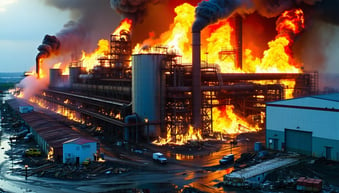February 1999 an explosion in a foundry in Massachusetts kills 3 and injures 9; January 2003 an explosion in a North Carolina pharmaceutical plant kills 6 and injures 38, February 2003 an explosion in a Kentucky acoustics insulation manufacturing plant kills 7 and injures 37, and February 2008 an explosion at a Georgia sugar refinery kills 14, and injures 38(1.).
What do all of these explosions have in common? Combustible dust fueled the massive explosions.
Since 1980 there have been at least 350 such explosions in the United States, killing 133 people and injuring hundreds more (2.). How much dust does it take to cause one of these explosions? According to NFPA 654, “As little as 1/32 of an inch of organic dust over 5 percent of a room’s surface area presents a significant explosion hazard;” that’s as thin as a paperclip.
These staggering figures have understandably brought heightened attention on the need to mitigate dust explosions. In June 2008 60 Minutes aired an in-depth story about the recent history of dust explosions; the NFPA has held classes at their recent conferences to better educate their members on the issue, and USA Today published a highly critical editorial in March 2008 urging OSHA to enact stiffer regulations on minimizing dust, the editorial argued, “Given how catastrophic these explosions can be and how long they’ve been happening, you’d think there’d be explicit regulations to spell out requirements for minimizing dust and indicating how to do that safely. But there aren’t.”(3) This attention led Congress to act, introducing H.R. 849, “The Worker Protection Against Combustible Dust Explosions and Fires Act”, that would require OSHA to issue rules regulating combustible dust levels.(4)
There are standards to deal with combustible dust however; the NFPA has issued NFPA 654: Standard for the Prevention of Fire and Dust Explosions from the Manufacturing, Processing, and Handling of Combustible Particulate Solids. This standard helps us understand the elements of a dust explosion and ways to prevent such an event. First, there are specific elements that need to be in place for a dust explosion to occur; a sufficient amount of combustible dust, an ignition source, oxygen in the air (oxidizer), dust needs to be suspended or dispersed into the air, and lastly the dust cloud needs to be in a confined space. These five factors combined are known as the “Dust Fire and Explosion Pentagon”. All of the five components of the Pentagon need to be in place for the explosion to take place (1). When looking at the five components of the Pentagon the obvious first conclusion is that two of the elements really can not be eliminated, oxygen and the existence of a confined space, so the focus automatically shifts to ways to eliminate the other three elements.
NFPA 654 provides valuable insight into how to control the other three elements of the Pentagon (dust levels, ignition, and dust dispersion). Given the potential variables when looking into the types of dust, types of manufacturing processes, and types of building occupancies, the permutations and combinations of methods to reduce dust explosions are virtually limitless and germane to every facility. But there are some basic recommendations to follow. The NFPA recommends:
- Use appropriate electrical equipment and wiring methods;
- Control static electricity, including bonding of equipment to ground;
- Control smoking, open flames, and sparks;
- Control mechanical sparks and friction;
- Use separator devices to remove foreign materials capable of igniting combustibles from process materials;
- Separate heated surfaces from dusts;
- Separate heating systems from dusts;
- Minimize the escape of dust from process equipment or ventilation systems;
- Use dust collection systems and filters;
- Utilize surfaces that minimize dust accumulation and facilitate cleaning;
- Clean dust residues at regular intervals;
- Use cleaning methods that do not generate dust clouds, if ignition sources are present;
- Only use vacuum cleaners approved for dust collection;
- Develop and implement a hazardous dust inspection, testing, housekeeping, and control program (preferably in writing with established frequency and methods). (1.)
These are just a few of the ways to help prevent the possibility of a dust explosion. In taking on these measures be prudent not to inadvertently increase the risk of an explosion when you are trying to alleviate the problem. If trying to reduce dust on the rafters, walls, and ceilings, make sure whoever is performing the cleaning employs an inherently safety, or explosion proof vacuum, that is properly grounded and by no means causes clouds of dust. If retrofitting your facility with new equipment ensure that all of the surrounding areas have had the dust remediated prior to performing tasks. While these are common sense measures, our experience has shown that many of these steps are not followed and in turn your facility, you, and your building’s occupants are at risk from a dust explosion.
References:
(1.) U. S. Department of Labor Occupational Safety and Health Administration, “Combustible Dust in Industry: Preventing and Mitigating the Effects of Fire and Explosions” Washington, DC, 2008.
(2.) Bach, Joel, Gelber, David, “Is Enough Done To Stop Explosive Dust?” 60 Minutes, June 8, 2008.
(3.) Editorial Board, USA Today, “Our View on Occupational Safety: At Worker’s Peril, Regulators Ignore Warnings on Dust.”, USA Today, March 26, 2008.
(4.) United States House of Representatives, Committee on Education and Labor, Press Releases, “Reps. Miller and Barrow Reintroduce Bill to Protect Workers from Dust Explosions at Industrial Work Sites.”, February 4, 2009


